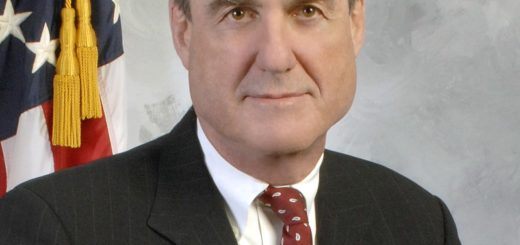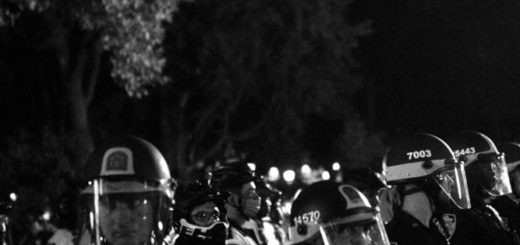Towards Becoming a Photographer
I never intended to become a protest photographer.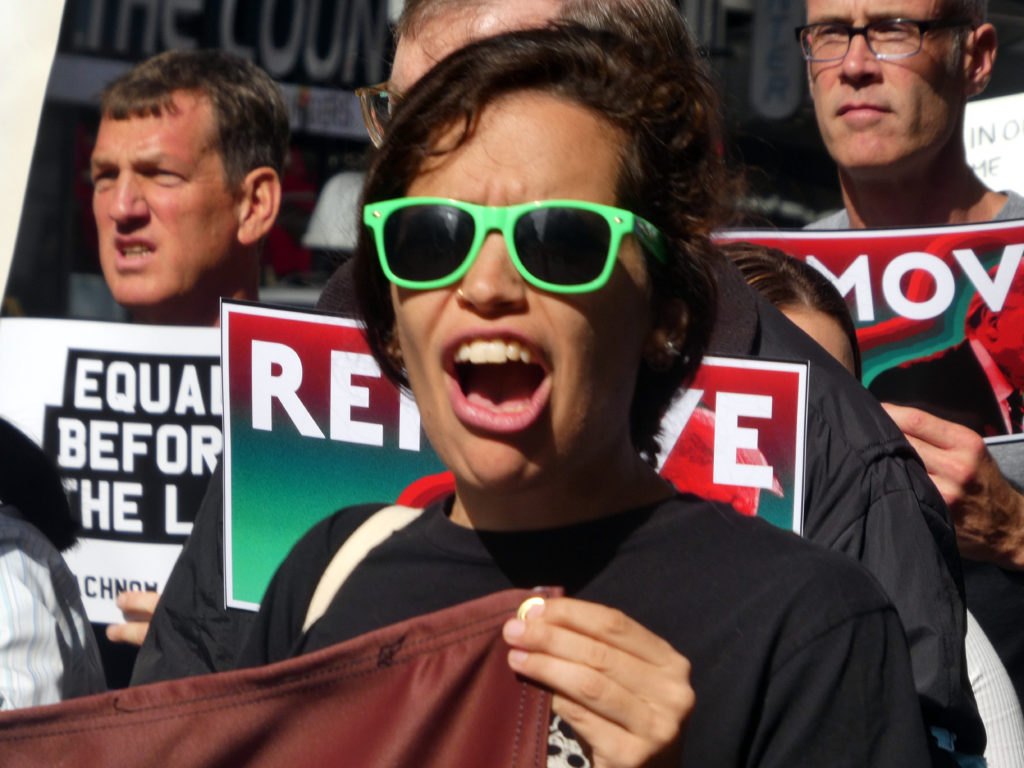
I rarely expressed artistic creativity in my youth. I was so focused on math and sciences, always seeking the inner beauty and surety of mental constructs expressed as equations. And then I discovered computers. Literally an imaginary world translated into reality by electrons. The Turing machine, though I only learnt of Turing’s theoretical work from before World War II (his work during the war was classified and von Neumann stole the credit).
So you might think that I was totally left brained, involved only in logical thinking. But not so, for to me the intuition was everything. Linear algebra was all about picturing a lattice in my mind, moving through an ethereal space in the mind’s eye. Transformed by translation, sheared, rotated. Differential equations of balls on springs. The equations are a way of distilling the image in the mind’s eye into symbols on a page, where they can be solved by the magic of mathematical manipulation, only to spring anew into intuitive imagination.
Right brain creativity feeds left brain analysis, which returns the favor afresh.
Not that I was completely devoid of artistic sense. I did a reinterpretation of a Vermeer painting in Impressionistic style once. It is long lost, submitted to the University of London for my ‘O’ level matriculation exam. And my love poems are long gone.
I spent a whole career on computers. I would even buy books on programming, telling myself that they were for career advancement, whereas in reality I was reading them with rapt attention as though they were novels. I waited for the denouement where the workings of another piece of technology could be made clear as the hidden mystery of a detective novel. The feeling of mastery.
My creativity was expressed in the art of making programs. My goal was sweet and simple solutions, with an elegance that my fellow programmers could follow and make part of their repertoire.
And what of the arts? Next to nothing. Even the novels that I would read were science fiction, I amassed a considerable trove. Occasionally Hannah and I would venture into Manhattan to see a show or a museum, but this was a rarity. It was not until after we divorced that I discovered that I could go to an opera for $35 at the Met, the music reaching all the way to the rafters, the singers clearly visible if I remembered to bring binoculars. We lived like monks in the vibrant cultural scene of New York.
When I reluctantly left our marital home, I started writing. I discovered that I had a voice that others appreciated, and converted my web site about scuba diving into a blog. Admittedly, my most read page is still the one about scuba diving terminology, but I have a fair number of readers of my accounts of different experiences.
Then Hannah came home from her trip to Iceland with her friends, and I was insanely jealous. We could have gone together to Iceland when we were married, but in our later years together she took to taking vacations without me. Her adventures in Iceland were amazing, but most of all were her descriptions of seeing puffins in their burrows. Though her photos were only blobs in the distance, she described how the puffins would fly in from the ocean having fed all day, and then suddenly disappear into their holes. Utterly fascinating. But awful photos.
I resolved to go to Iceland myself, have a grander adventure than hers, and get better photos of the puffins. Research would be everything. After endless poring over the internet I booked a camper van to travel the ring road around Iceland. I plotted the sights and mileages on Google Maps obsessively.
And even more obsessively, I researched a camera to buy. A good DSLR (digital single lens reflex) was far beyond the amount I was willing to pay, and I did not want to be burdened with an enormous camera. I discovered the “travel camera”: as small as a pack of cigarettes, with a built-in zoom lens and 16 megapixels, enough to compare with all but the highest end DSLR camera. And specifically the Panasonic Lumix ZS60 could be had for about $250, with optical image stabilization, a Leica lens, and 30x zoom; competing with a DSLR and zoom lens costing eight times as much.
Those puffins would never know what was coming.
But before I went to Iceland, I realized that I needed to find my way around my new acquisition. It would do me no good to be pressing buttons at random with my fingers freezing on a glacier. I should take my camera on lunch time walks, and gain a basic familiarity with the menus. I learned how to let it take an image in automatic mode, and recovered my memories of high school physics about aperture and focus. With a small aperture bokeh (deliberately blurring the background) was not possible, but the zoom capability was impressive, probably only possible because of the image stabilization. And I started learning about the digital darkroom of Photoshop (or rather GIMP, the free and open source competitor.)
Eventually I traveled to Iceland, and took the ferry to the Westman Islands. The ferry was in the evening, and as planned I reached the observation hut provided by the local chamber of commerce at about 10:30pm. The puffins feed on the ocean during the day, and return to their burrows to feed their pufflings at the close of day. This is not till after midnight, and although the sun does technically set it is never darker than twilight.
As I waited the two hours until I would have my shot at puffins, other tourists arrived to observe. I could hardly believe that when I informed them of the wait, they gave up and leave. How many thousands of miles and hours in the air had they traveled, only to give up for the sake of waiting a couple of hours.
I was alone by the time the puffins arrived. July is not in fact the peak of the season, but slowly the numbers built up. Eventually one landed close enough that I got a close up before it disappeared, and my extravagance was redeemed. I got the shot.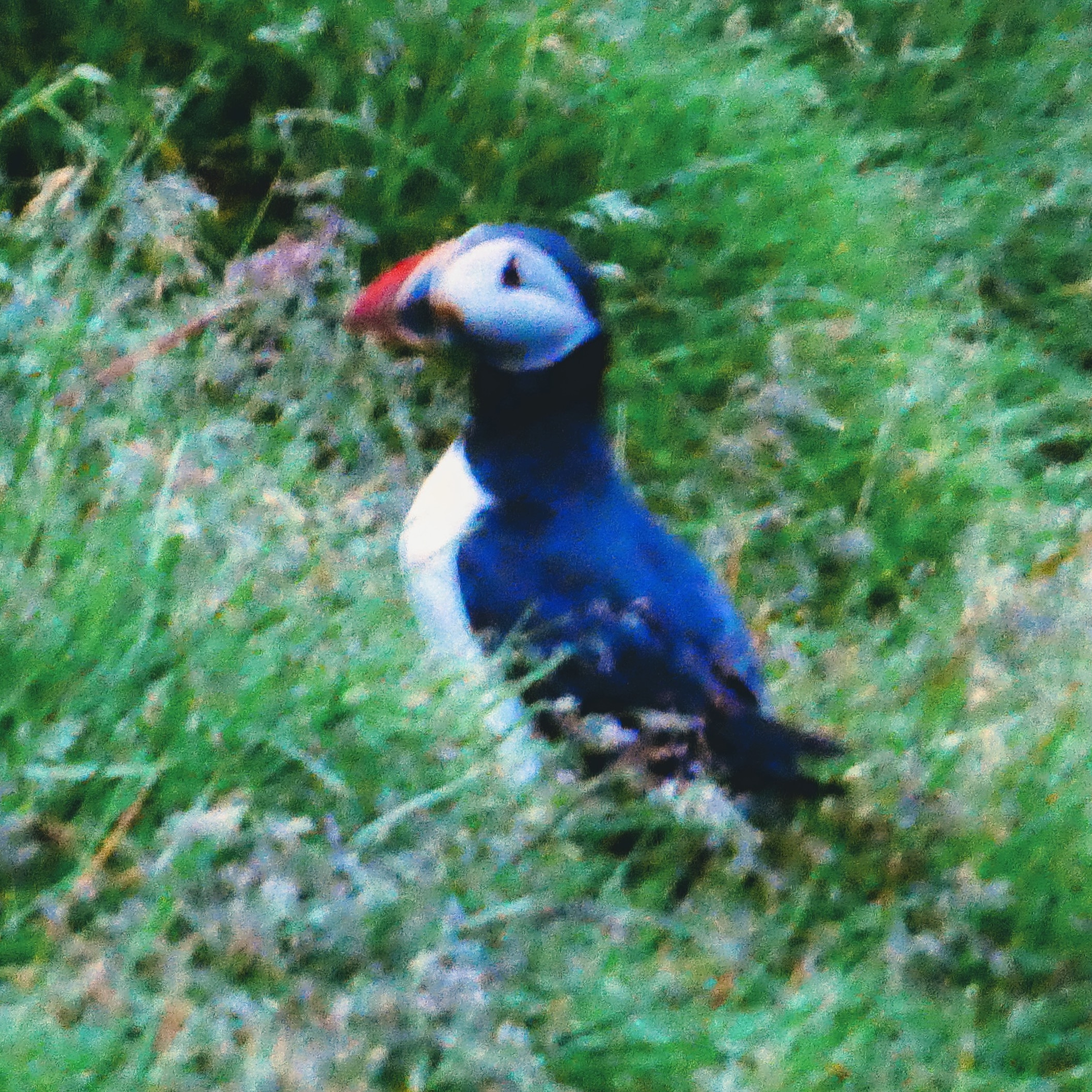
And I do have the shot. Much later when my sister in England showed my mother my Instagram, that was her favorite shot. It’s not an award winning shot, but it is worthy of my $250 camera. Take that Hannah!
But what does this have to do with protest photography?
“Write what you know!” Beloved of English teachers, I knew that this applied as much to other media. I had dipped my toes in by following street photographers on Instagram. I was already heavily involved in protesting against Trump. What better way to explore this new interest than by photographing what I had been organizing?
My image of protest photography was the fictional photographer in The Unbearable Lightness of Being, capturing arresting images of Russian tanks in the Prague Spring. Or Bernie Boston’s Flower Power photo of a hippie putting a carnation in the barrel of a rifle. Or John Filo’s photo of the Kent State massacre.

Flower Power: Bernie Boston

Kent State Massacre: John Paul Filo
So I started taking my camera to protests. My first outing was to a protest against Amazon providing technical support to the Immigration Customs Enforcement jackbooted thugs. I like to think that my depiction of a newborn in the arms of his grandmother holding space in the Amazon store in mid-town Manhattan had some merit. I had learned something of the elementary rules of composition from endless hours watching my mother at work, and taking us to galleries.
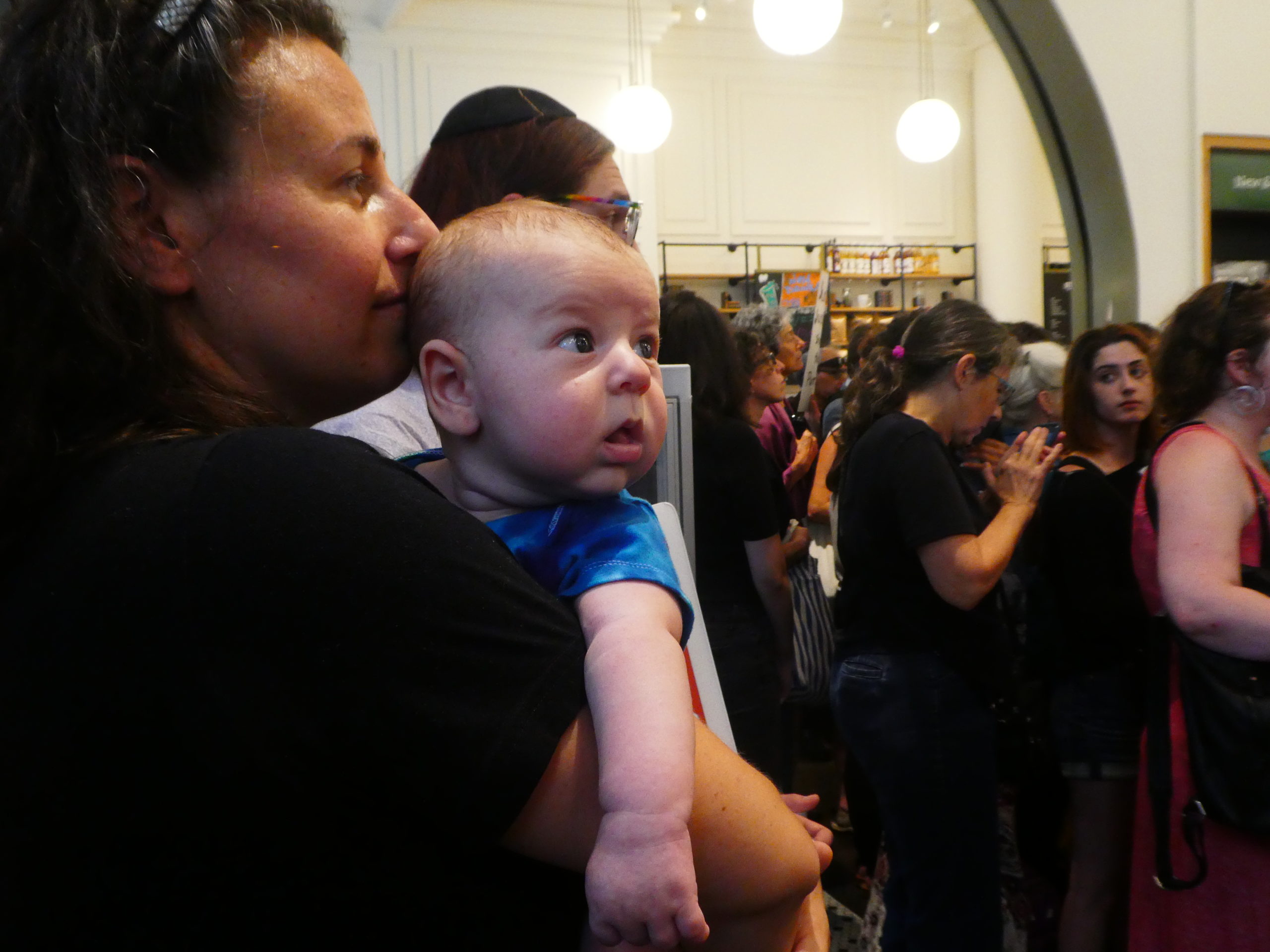
No Tech For ICE – Amazon Store Sit In: Wrolf Courtney
I started to learn the craft of protest photography on the job. There are a few photojournalists who make it their business to capture images of protests either freelance or on assignment, and they welcomed me with open arms. I copied them as they backed in front of a banner leading a march, or getting a power angle of a protestor by crouching low. I even got a selfie stick to use as a pole to get a shot looking down on demonstrators. Posting to social media, I am no competition to them as they try to sell their images to mass media. They even give me tips.
Eventually I upgraded from my travel camera to a mirrorless, the new generation that is replacing DSLRs. I have a Sony A6500 that I picked up used from Adorama, plus a Sigma 30mm and a Sony 55-210mm. On an APS-C camera the 30mm is the equivalent of a 50mm on a full frame camera, and I almost never use the zoom lens. My “nifty 50” (equivalent) has exactly the field of view that I want to naturally cover a protestor carrying a sign, or from a little further back a banner or line of protestors. The modern mirrorless body is so light that most of the weight is actually the lens, I barely feel it for the hour or so I am shooting. And the through the sensor viewfinder actually gives me a better feel for how the shot will look on digital media than the optical viewfinder of a DSLR.
It’s all about the aperture. I can get a shot in the gloomy depths of Grand Central Terminal that I could not possibly get on my travel camera, or on a cell phone, since the lens opens so much wider to let more light in. Here’s a picture I took at Washington Square Park after sundown by available light.
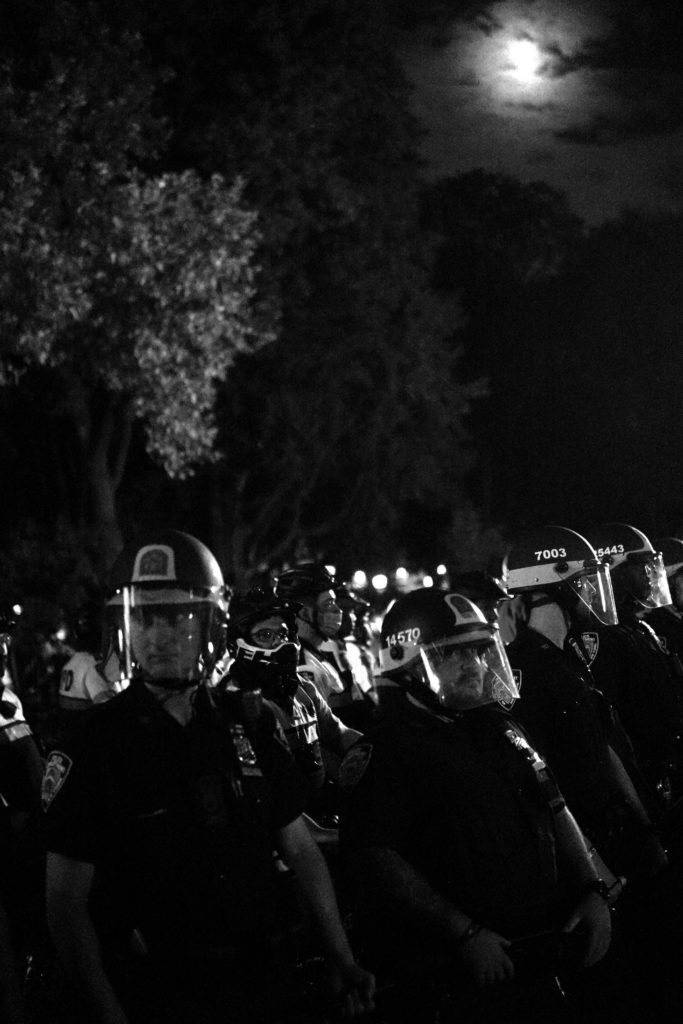
Cops vs. BLM by moonlight
At this point, I feel that I can document the purpose of a protest, projecting it beyond just the passers by to a much wider audience on social media. And at times I feel that I capture the mood of the protestors, their feeling of common purpose, their shared passion. And that is when I feel it is all worthwhile.

Wrolf Courtney
Follow me on Instagram as @realwrolf
